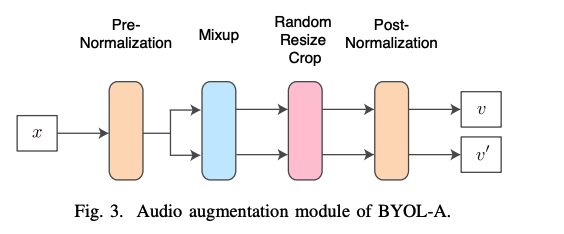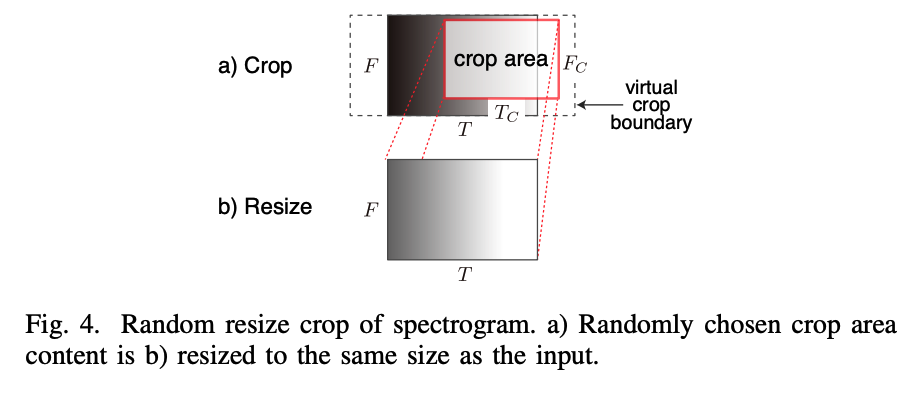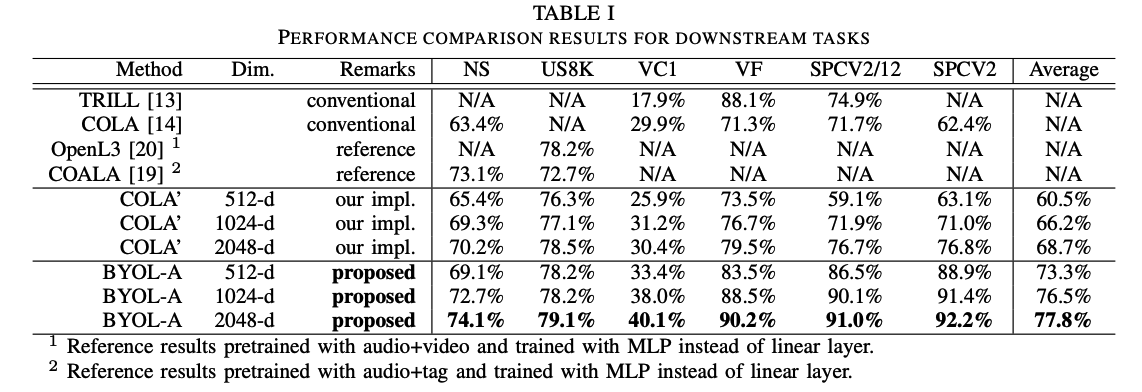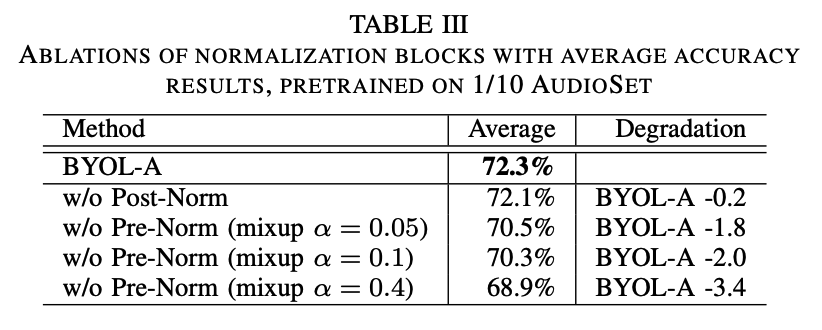BYOL for Audio: Self-Supervised Learning for General-Purpose Audio Representation (IJCNN, 2021)
https://arxiv.org/pdf/2103.06695.pdf
Contents
- Abstract
- Introduction
- BYOL-A
-
Pre-normalization
-
Mixup for foreground acoustic event
-
RRC for all content details
-
Post-Normalization
-
- Experiments
Abstract
New general-purpose audio representation learning approach!
No negatives samples ( \(\approx\) BYOL )
- without expecting relationships between different time segments of audio samples.
Bootstrap Your Own Latent (BYOL) for Audio (BYOL-A)
- creates contrasts in an augmented audio segment pair derived from a single audio segment
- combination of normalization and augmentation techniques
1. Introduction
Contrastive Learning
- use positive and negative samples
- requires a large number of negative samples
- SimCLR [7] : uses a significant number of batch samples
- MoCo [6] : operates a large queue to accommodate a larger number of negative samples.
- BYOL [8] : does not use negative samples
Bootstrap Your Own Latent (BYOL)
-
no negative samples
- directly minimizes the MSE of embeddings originating from the same input
- collapsed representations? system architecture and training algorithm can avoid this problem!
SSL in Audio
COLA [14]: learns general-purpose representations and outperforms previous methods
Others: utilize the time-series aspect of audio signals
-
audio segments cropped closer = closer representations (?)
\(\rightarrow\) contradictory use cases can be found easily!
- ex) repetitive sounds like music could have similar contents in the remote time segments because music compositions, by their nature, repeat motifs.
ex) short acoustic events (e.g., a single knock, a gunshot) can occur in a short duration
- even adjacent segments (e.g., a knock followed by a footstep) can make differences in contents for acoustic events.
-
similar problems can also happen when we use contrastive learning [11] [14] or triplet loss [12] [13] because the comparison of multiple samples is the core of their loss calculation.
BYOL-A
Address these problems by having general-purpose audio representations , learned from a single audio segment!!
Focus on learning
-
(A) the foreground acoustic event sound as a dominant sound representation
-
(B) the sound texture details
for describing general-purpose representation.
(A) Foreground acoustic event
-
Can be better learned from samples with random background variations while the foreground is kept unchanged
-
mixing small amount of sounds can approximate making variations on the background.
\(\rightarrow\) adopt “mixup”
(B) Sound texture
-
Sounds from an acoustic scene or a sound texture can vary their pitch/speed/time, while the details can be consistent
-
details can be learned under the random variations of pitch/speed/time shifts
\(\rightarrow\) use approximation of audio “pitch shifting” and “time stretching” techniques
Create changes on a pair of segments originating from exactly the same segment, not from multiple segments
Contributions
- (1) Propose learning general-purpose audio representations from a single audio segment
- (2) BYOL for Audio (BYOL-A)
- learns representations from a single audio segment input with a dedicated audio augmentation module that focuses on foreground and content details
- (3) Propose to learn ..
- a) foreground sound by combining pre-normalization and mixup
- b) content details through approximation of pitch shifting and time stretching.
- (4) Extensive ablation studies
2. BYOL-A
General-purpose audio representations from a single audio segment

(1) Input : audio preprocessed as a log-scaled mel-spectrogram ( = time frequency feature )
(2) Data Augmentation: replace the augmentation module in BYOL with ours
-
so that the learning system can handle audio and create contrasts in augmented views
-
augmentation module consists of 4 blocks
-

Data Augmentation blocks
-
(1) Pre-Normalization block
-
normalizes a single input audio segment ( for stability )
-
normalized input is duplicated into 2copies
-
-
(2) Mixup block : creates two outputs that are mixes of ..
- a) normalized inputs & b) randomly chosen past normalized inputs.
- designed to create contrast for learning foreground acoustic event representations,
-
(3) Random Resize Crop (RRC) block
- resizes and crops the outputs randomly
- approximates pitch shifting and time stretching in time-frequency features
-
(4) Post-Normalization block
- adjusts statistical drifts caused by the former augmentations
- focus on foreground acoustic events and all content details.
(1) Pre-Normalization
-
normalized to \(\tilde{x}=\frac{x-\mu}{\sigma}\),
-
stabilizes computations in the system in two ways
- (1) by mitigating augmentation parameter sensitivity
- which enables following blocks to assume that input range virtually follows \(N(0,1)\).
- (2) by normalizing statistical differences between training datasets.
- (1) by mitigating augmentation parameter sensitivity
(2) Mixup for foreground acoustic event
Input = normalized log-mel spectrogram audio
Mixup block
-
mixes past randomly selected input audio in a small ratio
-
added audio becomes a part of the background sound in the mixed audio.
-
similar to mixback [11], which adds a random sample from a dataset as background sound
( but the purpose of the mix-back is to create a set of positive samples sharing less information in the contrastive learning setting )
-
-
Original mixup = to both X & Y
BYOL-A = only to X
As audio is log-scaled, we convert input to a linear scale before the mixup calculation and convert it back to a log-scale again
\(\rightarrow\) coin as log-mixup-exp
\(\tilde{x}_i=\log \left((1-\lambda) \exp \left(x_i\right)+\lambda \exp \left(x_k\right)\right)\).
-
\(x_k\) : mixing counterpart
-
\(\lambda\) : mixing ratio sampled from uniform distribution \(U(0.0, \alpha)\)
( instead of from a beta distribution in the original mixup )
(3) RRC for all content details

approximation of pitch shifting and time stretching of input audio log-mel spectrograms
(4) Post-Normalization
After augmentation … can cause statistical drift in their outputs
\(\rightarrow\) Thus, normalize as \(\sim N(0,1)\).
Difference with pre-normalization?
- use BATCH statistics ( not INSTANCE-WISE )
3. Experiments



